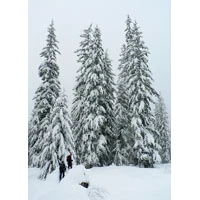
A plant's ability to withstand the cold depends upon many factors including the species of plant, plant condition, the time of year along with how low and how fast temperatures drop as well as the duration of the freeze. Damage can range from temporary wilting, blackened leaves or mushy leaves and buds or the death of the plant.
If the temperature drops gradually, it is easier for the plant to acclimate to the colder temperatures. Sudden temperature drops, a rapid freeze or a prolonged freeze can kill or damage plants. Early flowering, young tender plants, bulbs, fruit, and drought or root damaged trees and shrubs may need special protection to avoid damage. The California Landscape Contractors Association (CLCA) offers some recommendations to help protect your plants during the winter cold and sudden temperature drops.
Preparing for a freeze
- Healthy, hydrated plants are more resistant to injury from cold than newly planted ones or plants weakened by disease, drought, insects or improper care. Even if your plants have always survived cold weather, if your plants have been affected or weakened by disease, drought etc., you might wish to consider additional protection this year.
- Mulching with a partially composted material is one the best ways to protect plant roots because it helps insulate the soil, reducing heat loss and minimizing temperature fluctuations. Protecting the roots is necessary in order for them to survive the cold. However make sure the mulch is pulled away from the area where the plant stem meets the soil so the stem will not rot.
- Be sure to check the mulching material about once a month to make sure that moisture is getting to the soil below. Avoid using weed block materials, plastic or other barriers to moisture beneath the mulch so that water can get to the roots. You may also need to water some of the drier areas in mid-December or mid-January if you find the soil dry.
- When a freeze is forecast, give your plants a good watering a couple days in advance. Moist soil absorbs heat during the day and radiates it out on a cold night. Active plants with adequate moisture content can better resist freeze damage. Plants can also be gently sprayed with mists of water to create an ice blanket, which helps insulate and protect the plant. Applying water just prior to freezing temperatures combined with a protective cover can be extremely helpful in reducing freeze damage and can also be a life-saver.
- Container plants are especially susceptible to cold damage because their roots have little ability to acclimate or develop tolerance to the cold. Their soil occupies a limited space and is exposed to cold on all sides. The ground can stay well above freezing on a very cold night, but the soil in a container will get almost as cold as the air. The best way to protect container plants is to bring them indoors into a garage. Be sure to check that you are not bringing in any lizards, frogs or other critters that may be taking shelter in your container plant. Also, avoid temperature shock and don’t put them in a heated area. As soon as the weather improves put them back outside immediately.
- If you are unable to bring the plants indoors, try to group them together in a protected location up against the home or even under the eaves or a carport and cover them with a light blanket, sheets, tablecloth, polypropylene material, custom plant blankets or other cloth for the night. The south and west sides of the home are typically the warmest. If the container is too big to move, you can mulch around the container or wrap the base with a blanket or other cloth.
- Covering a plant with cloth is one of the most effective ways of protecting a plant during extremely cold weather. Make sure the cover extends all the way to the ground so that it can trap in the heat. Plants do not produce heat but the soil does. Rocks and clothespins are effective ways to help keep the cover on and better insulate the plant from the elements. Be sure to remove the covers daily when the temperature is above freezing. The additional weight of a wet cloth can break delicate branches. Wood stakes or tomato cages around the plant can keep the covering up and off the leaves. Small plants can also be covered with cardboard boxes placed upside down over the plant.
- Do not use plastic materials to cover your plants. Plastic can burn the leaves it touches on a cold night and it also cuts off air to the plant. In addition it acts as a greenhouse taking plants from nightly lows to much higher temperatures during the day. This rapid temperature change can cause serious freeze damage or can be fatal to plants.
- A method often used to protect large trees too big to cover is to wrap the trunks with Christmas lights and leave them on all night. The small twinkle lights and LED lights do not generate heat, so you will need the larger bulbs for this to be effective.
What do I do during a freeze and if it snows?
- During a freeze, if the ground is frozen, water may be unavailable to the plants. Plants continue to transpire (lose water from their leaves) and dry out during the day. Watering the soil to thaw the ground can make the water available to the roots. Check the soil for moisture and do not water too much or too often. If the soil becomes too saturated, it may cause damage to the root systems or cause damage from ice build up. Continue to check the water needs of the plants for several days after a freeze.
- A light coating of snow is actually excellent protection for plants. It helps insulate the ground around the plants and helps protect the leaves.
- Heavy, wet snow can cause considerable damage. It can place tremendous weight on leaves and branches causing them to fall off. To better protect your plants, it is a good idea to shake off excess snow from leaves and branches before any damage occurs.
What do I do after a freeze?
- In general, many plants and trees are exposed to freezing or cold temperatures in their native environment and most will recover and should be left alone. Unless necessary to prevent additional damage or damage to property, any pruning or cutting back of damaged plants should not be done until spring. Removing bark, leaves or limbs can expose the plants to additional damage, especially if another cold snap or frost occurs. It is best to leave them alone.
- The full extent of damage to woody plants may not be apparent until the next spring or summer season. Re-examine them at that time and then carefully remove damaged wood to make room for new growth. To determine if wood has been damaged, check the layer directly under the bar for black or brown discoloration and then prune the wood below the discoloration. If in doubt, it is better to wait until damage is obvious rather than removing live tissues.
- If you have hazardous tree limbs overhanging a home or driveway that have broken off due to the weight of heavy ice or snow, be sure to remove, repair or brace the damaged limb(s) with cables. However like other plants, it is best to leave trees alone and keep as much live foliage and wood as possible. If the tree appears damaged in the spring, be sure to consult an arborist to see what is wrong with the tree and whether it can be restored or if it needs to be removed.
Latest from Lawn & Landscape
- Caterpillar's Cheryl H. Johnson set for April retirement
- Registration open for sixth annual Lawn & Landscape Technology Conference
- 12 interview questions to help you hire winners
- To Lease or Not to Lease
- TruGreen taps Brian Bugara as chief revenue officer
- The Toro Company names Conserva Irrigation as 2024 Water Smart Partner of the Year
- Bland Landscaping acquires Koehn Outdoor
- The first issue of 2025 is live





